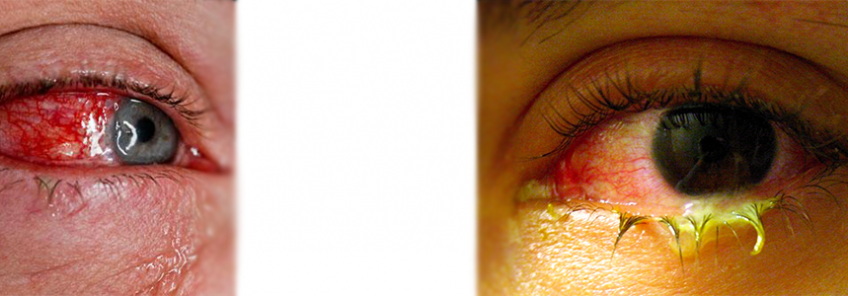Conjunctivitis

- Viral conjunctivitis: This is caused by a family of viruses called, Adenovirus and is highly contagious. Initial symptoms are fever, sore throat and runny nose, watery discharge and ‘sandy’ feeling in eyes.
- Bacterial conjunctivitis: This is commonly caused by Staphylococcus or Streptococcus group of bacteria, and is contagious. It causes yellow, white or green discharge from eyes. Bacterial conjunctivitis can be classified into:
- Hyperacute bacterial conjunctivitis, which is caused by Neisseria species (esp N gonorrhoeae) of bacteria. It causes redness, copious purulent discharge and loss of vision, if not treated promptly. It is acquired by contact with infected genitalia in person with gonorrhea (sexually transmitted infection).
- Gonococcal conjunctivitis is the infection in newborn transmitted by infected mother during childbirth.
- Chlamydia conjunctivitis is a cause for Trachoma, which can lead to blindness.
- Allergen in air (like dust or pollen or other specific allergens) can also cause conjunctivitis. Symptoms may be sudden in onset and could be seasonal or persist throughout the year.
- Some irritants like shampoo, chlorine, foreign bodies including contact lens can cause conjunctivitis.
- The eyes look red, become itchy and watery;
- One or both eyes may be involved;
- Mild pain or foreign body sensation;
- Eye discharge look yellow, white or green;
- Eyelids often stick together with gluey material after a sleep;
- Vision may or may not be affected.
- Marked eye pain;
- Vision is affected and you cannot see properly;
- Difficulty looking in bright light;
- Blisters occur on skin around the eyes;
- Red eye in person with penile or vaginal discharge;
- Eye problem in contact lens users;
- Newborn baby gets conjunctivitis;
- Other eye symptoms that are not getting better.
- Bacterial conjunctivitis: Milder form may resolve by itself. More severe forms are treated with antibiotic eye ointments and drops. Gonococcal conjunctivitis (in adults and newborn) is a serious condition and should be treated on emergency basis.
- Viral conjunctivitis: Symptomatic treatment with lubricating agents, decongestants and antihistamine eye drops are used. There is no specific antivirals.
- Allergic conjunctivitis: Treated with anti-allergy eye drops (antihistamines, mast cell stabilizers) and by avoiding allergens, where possible.
- Irritants: Remove irritants (like contact lens, foreign body) and use lubricant eye drops.
- Viral and bacterial conjunctivitis both spread by direct contact with discharges and contaminated objects. Maintenance of personal hygiene like frequent hand washing is important.
- Do not share clothes, towels, handkerchiefs, bed sheets etc. with the infected person.
- To avoid spreading infections from one eye to the other, apply drops only to affected eye, and wash hands thoroughly after application.
- If you have conjunctivitis, contact your physician about returning to work, particularly, if your are involved in health care or dealing with children.
- If you have conjunctivitis, avoid contact with very old, very young and people with a weak immune system because they are more prone to catch infection.
Conjunctivitis is an infection or inflammation of conjunctiva, a thin layer that covers the white part of eye and inner parts of the eyelids. Normally, transparent conjunctiva becomes red or pink when inflamed. It is caused by infectious (spreads easily from person to person and from contaminated objects) or noninfectious cause.
When you have conjunctivitis, one or both eyes get infected and causes sticky eyelids and discharge from eyes (watery or purulent). Most conjunctivitis are due to allergens and virus, and resolve without any medical attention. However, viral conjunctivitis is highly contagious and some bacterial conjunctivitis can even cause permanent blindness.
Common causes
Conjunctivitis can be caused by infection, allergy or an irritant:
Infection:
Allergy:
Irritant:
Symptoms
Conjunctivitis is exhibited with these symptoms:
When to seek care
You should immediately see a doctor if any of the following symptoms of complicated conjunctivitis occur:
Treatment options
History and physical examination by a physician can make diagnosis of conjunctivitis. Sometimes additional tests and consultation with Eye specialist is needed.
Most allergic or viral conjunctivitis are self-limited and require no medical intervention, whereas other forms require specific treatment.
Prevention
These are some of the ways you can prevent conjunctivitis:



Send us your feedback on this article